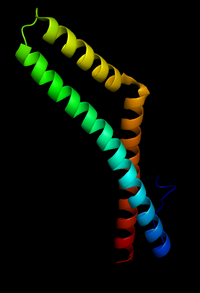
Photo from wikipedia
Delivery of putative compounds of therapeutic value to the brain is limited by brain barriers: the blood–brain barrier located in the endothelium of the brain microvessels (BrMV) and the blood–cerebrospinal… Click to show full abstract
Delivery of putative compounds of therapeutic value to the brain is limited by brain barriers: the blood–brain barrier located in the endothelium of the brain microvessels (BrMV) and the blood–cerebrospinal fluid barrier located in the epithelium of the choroid plexus (ChP). Understanding their function and modulation by the circadian clock may enhance the efficacy of brain-targeting therapies. The aim of the present study was to evaluate the stability of 10 reference genes in the BrMV and ChP, isolated from male and female rats at six time points (ZT1, 5, 9, 13, 17, and 21). Gene evaluations were performed by qPCR, analyzed by RefFinder tool, and verified by analyzing the expression of the brain and muscle ARNT-like 1 (Bmal1) using the qPCR and digital PCR methods. We identified as the most stable genes for circadian studies tyrosine 3-monooxygenase/tryptophan 5-monooxygenase activation protein zeta (Ywhaz) and apolipoprotein E (Apoe) for BrMV, and beta actin (Actb) and hypoxanthine-guanine phosphoribosyltransferase (Hprt1) for ChP. After verification, ribosomal protein (Rps18) was also included as a sufficient reference gene. Additionally, the observed gender difference in the Bmal1 oscillations in both BrMV and ChP suggests that separate studies for each gender are recommended.
Journal Title: Biomolecules
Year Published: 2021
Link to full text (if available)
Share on Social Media: Sign Up to like & get
recommendations!